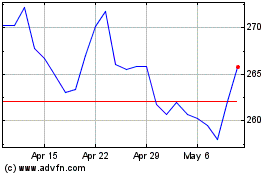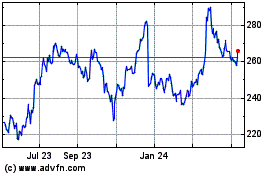By Laura Stevens
FedEx Corp. on Wednesday cut its earnings outlook for the year,
blaming weaker demand for its freight services, higher costs in its
Ground division and higher insurance costs.
The move came as the delivery giant missed Wall Street
expectations for the quarter despite a 6% increase in profit as
restructuring of its Express division pays off and the company
experiences a surge in e-commerce growth.
FedEx said it expects adjusted earnings of $10.40 to $10.90 for
the year ending May, down from its previous guidance of $10.60 to
$11.10 a share.
FedEx's stock price has dropped from a high of about $185 in
June to $147.68 in recent trading. Shares have declined since the
company missed earnings expectations in June owing to litigation
costs and a $2.2 billion pretax charge as it changed its
pension-accounting method. Also weighing on the stock, FedEx is
more exposed to Asia than some of its rivals, a concern because of
the weakening global economic environment.
On an earnings call with analysts, executives said that they are
confident that the company has the right amount of capacity in its
Asia-Pacific network. In addition, most of its business exposure in
China is serving multinational companies. And while costs were up
in its freight and ground segments for the quarter, executives said
that those were one-time items, and that those businesses are still
well positioned for longer-term growth.
Chief Executive Fred Smith said that without increasing its
self-insurance reserves, the company would have beat Wall Street
expectations for the quarter and kept its full-year guidance.
"All the rest of the stuff is just noise and various issues
inside the operating company, so it's important that you focus on
that one issue," Mr. Smith said.
The increased self-insurance reserve, which accrues in part as
the company puts more trucks on the road and drives more miles,
lowered the Ground business's first-quarter operating margin by 1.7
percentage points. That helped reduce Ground's operating margin to
14%, from 18.4% a year ago.
FedEx's Ground business, which contributed about a third of
total revenue, was hurt by other one-time items. It spent more
money as it integrates GENCO, a company that specializes in product
returns, which FedEx acquired for $1.4 billion this year. In
addition, FedEx is taking its Smartpost business, which uses the
U.S. Postal Service to deliver packages the so-called "last mile,"
and incorporating it into Ground.
Average daily volume for Ground's package business grew 4% in
the quarter, which was about in line with the company's
expectations. But a higher percentage than expected--about half of
both Ground and Express deliveries in the U.S. now--is residential
traffic owing primarily to the increase in e-commerce, executives
said.
An analyst questioned whether the change in the business mix
lowered Ground margins. Small, slow e-commerce parcels are
typically less profitable than business-to-business shipments,
where a delivery driver is usually dropping off several heavier,
more urgent and expensive packages at one location.
"E-commerce is clearly changing the dynamics of the industry,
and it's driving incredible growth," said Henry Maier, head of
FedEx Ground. "I think we're best positioned to benefit from the
e-commerce economy."
Ground's operating income slipped 1% to $537 million, while
revenue shot up 29% to $3.83 billion in part from the addition of
GENCO.
The company also provided guidance on what it expects to be
another record holiday season, saying it plans to hire more than
55,000 employees, up from 50,000 last year. FedEx is working
closely with retailers to forecast package shipments, but warned it
plans to turn away packages it doesn't have room for, something it
did in past years.
The company also outlined its plans to charge more for oversize
packages. The Wall Street Journal reported in July that rival
United Parcel Service Inc. was removing discounts on oversize
packages as e-tailers increasingly ship large packages that clog up
operations.
"More and more e-commerce companies are electing to ship those
packages through networks like ours rather than handle them in the
store, [and] we've seen an increase," said Mike Glenn, executive
vice president of market development, on the call.
Overall, for the first quarter ended Aug. 31, FedEx posted a
profit of $692 million, or $2.42 a share, up from $653 million, or
$2.26 a share, a year earlier. Profit in the prior-year period
included a benefit from its recent pension accounting change.
Revenue rose to 5% to $12.3 billion.
A bright spot for the company was continued improving margins at
Express, which contributes more than half of total revenue. The
company's restructuring of the division, which included buyouts and
modernization of its airfleet, helped boost the segment's operating
income by 45% to $545 million.
FedEx said costs went up at its Freight division, as volumes
fell unexpectedly and too many employees were left idle. Revenue
was flat at $1.6 billion, and operating income fell 21% to $132
million.
Chelsey Dulaney contributed to this article
Write to Laura Stevens at laura.stevens@wsj.com
Subscribe to WSJ: http://online.wsj.com?mod=djnwires
(END) Dow Jones Newswires
September 16, 2015 14:57 ET (18:57 GMT)
Copyright (c) 2015 Dow Jones & Company, Inc.
FedEx (NYSE:FDX)
Historical Stock Chart
From Mar 2024 to Apr 2024

FedEx (NYSE:FDX)
Historical Stock Chart
From Apr 2023 to Apr 2024
